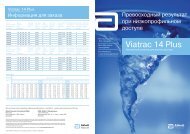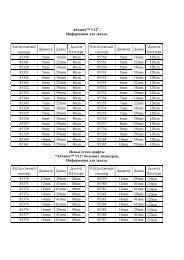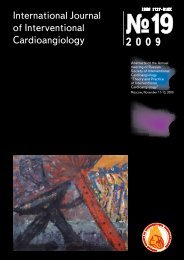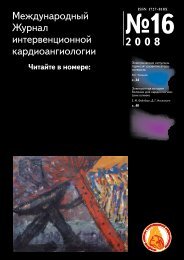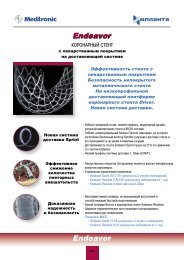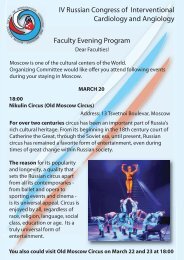International Journal of Interventional Cardioangiology
International Journal of Interventional Cardioangiology
International Journal of Interventional Cardioangiology
You also want an ePaper? Increase the reach of your titles
YUMPU automatically turns print PDFs into web optimized ePapers that Google loves.
MUSCELLANONEOUS<br />
Table 5. Mean reverse titers <strong>of</strong> ACAB in children with viral infections.<br />
ACAB type<br />
Groups <strong>of</strong> children with viral infections<br />
HI (n=18)<br />
ARVI (n=22)<br />
To endothelium 82.2±23.0 107.3±19.0<br />
To cardiomyocytes 147.8±27.6* 72.9±13.5*<br />
To conductive system 134.4±24.3* 79.0±15.4*<br />
To smooth myocytes 112.8±4.3* 74.0±8.9*<br />
Total titer 112.8±19.9 83.3±14.3<br />
* - significant difference (p< 0.05)<br />
In children with ARVI, total ACAB titer was practically<br />
equal to mean population level (83.3±14.3), and<br />
titers <strong>of</strong> antibodies to cardiomyocytes, conduction<br />
system, and smooth myocytes were lower than mean<br />
population levels (Table 5).<br />
CONCLUSION<br />
Thus, high ACAB production levels, mainly <strong>of</strong> antibodies<br />
to conduction heart system and cardiomyocytes,<br />
were observed in children with herpes infection. In a<br />
quarter <strong>of</strong> patients, his was associated with the minimal<br />
changes in the morphometric parameters <strong>of</strong> the<br />
left ventricle and in more than a half <strong>of</strong> children with<br />
HI – with conduction and repolarization disturbances<br />
on ECG.<br />
In children with ARVI, the levels <strong>of</strong> anti-endothelium<br />
Abs were higher than that in children with HI; it<br />
may be attributed to influenza virus endotheliotropism.<br />
On the contrary, titers <strong>of</strong> antibodies to other<br />
heart structures were lower than that in children with<br />
HI. In children from this group it was combined with<br />
less burdened cardiovascular familial history, less<br />
evident general and cardiac stigmatic signs, rare<br />
detection <strong>of</strong> the left ventricle dysfunction signs and<br />
evident positive ECG changes over time as compared<br />
to children with HI.<br />
Conclusions:<br />
1. High incidence <strong>of</strong> cardiovascular changes (premorbid<br />
pre-existing constitutional dysplastic<br />
features (MCM), vegetative disorders, toxic and<br />
infectious cardiomyopathy occurring in more than<br />
a half <strong>of</strong> patients) was revealed in children with<br />
viral infections, especially with herpes infection.<br />
2. The signs <strong>of</strong> vegetative dysfunction in children<br />
with viral infections have generally one-way pattern<br />
with prevalence <strong>of</strong> sympathicotonia in baseline<br />
vegetative tone with insignificant activity provisions<br />
and asympathicotonic reactivity.<br />
3. Toxic and infectious cardiomyopathy in patients<br />
with herpes infection is characterized with more<br />
prolonged course, signs <strong>of</strong> minimal left ventricle<br />
dysfunction, persistence <strong>of</strong> ECG changes over<br />
more than 14 days, and high mean titer <strong>of</strong> anticardiac<br />
antibodies.<br />
The features <strong>of</strong> clinical and immunological status<br />
in children with herpes infection are as follows:<br />
high values <strong>of</strong> anti-cardiac antibodies to conduction<br />
system and cardiomyocytes in combination<br />
with persistent conduction and repolarization disturbances<br />
on ECG.<br />
4. In 70% <strong>of</strong> children with ARVI, toxic and infectious<br />
cardiomyopathy was only observed during<br />
infectious toxicosis and was characterized with<br />
favorable prognosis, rapid positive changes over<br />
time as assessed by clinical and instrumental<br />
methods, absence <strong>of</strong> formation <strong>of</strong> anti-cardiac<br />
antibodies to the heart’s conduction system and<br />
cardiomyocytes, activation <strong>of</strong> development <strong>of</strong><br />
antibodies to endothelial cells due to endotheliotropism<br />
<strong>of</strong> influenza viruses.<br />
References:<br />
1. T.A. Ruzhenkova. Myocardium status in children with<br />
acute enteric infections: Avtoref. dissertatsii kand. med. nauk,<br />
Moscow, 2006, pp.24.<br />
2. P.G. Filippov. Cardiovascular lesions in some infectious<br />
diseases: Dissertatsya d-ra med. Nauk, M, 2001.<br />
3. Yu.P. Finogeev, Yu.V. Lobzin, V.M. Volzhanin, A.V. Semina.<br />
Cardiovascular lesions in some infectious diseases: clinical<br />
presentation, diagnostics, treatment. St.Petersburg, Foliant,<br />
2003, 44-47.<br />
4. Gorlitskaya, S.E. Zadorozhnaya, S.A. Khmilevskaya.<br />
Investigatttion <strong>of</strong> heart rhythm and conduction disturbances<br />
in children with infectious mononucleosis. Proceedings <strong>of</strong><br />
All-Russian Congress “Pediatric Cardiology – 2004”. M, 2004,<br />
87-88.<br />
5. N.V. Nagornaya, S.S. Ostropolets, E.V. Pshenichnaya.<br />
Persistent intracellular infection in children with heart rhythm<br />
disturbances. Proceedings <strong>of</strong> All-Russian Congress “Pediatric<br />
Cardiology – 2004”. M, 2004, 166.<br />
6. E.V. Sorokin, Yu.A. Karpov. Myocardites in clinical practice:<br />
modern conception on old disease. Kardiologya “RMJ”,<br />
2001, 10, 423-426.<br />
7. E.B. Zhiburt, N.B. Serebrenaya, V.V. D’yakova et al.<br />
Epstein-Barr virus in patients with infectious endocarditis. Ter.<br />
Arkhiv, 1997, 4, 42-43.<br />
8. T.V. Tolchtikova, L.V. Bregel', V.M. Subbotin et al. Secondary<br />
DCMP and coronary vasculitis in patients with Epstein-Barr viral<br />
infections. Proceedings <strong>of</strong> All-Russian Congress “Pediatric<br />
Cardiology – 2004”. M, 2004, 99.<br />
9. Jeffry J. Cohen The biology <strong>of</strong> Epstein-Barr virus: Lesson<br />
learned from the virus and host. Current Opinion in Immunology,<br />
1999, 11, 365-370.<br />
10. Li B., Xu C., Wang Q. The detection <strong>of</strong> antibodies <strong>of</strong> human<br />
cytomegalovirus in the sera <strong>of</strong> patients with coronary heart<br />
diseases. Zhonghua Nei Za Zh, 1996, Nov. 35(11), 741-743.<br />
11. Okano M. Epstein-Barr virus infection and it’s role in the<br />
expanding spectrum <strong>of</strong> human diseases. Act. Paediatr., 1998,<br />
Jan., 87(1), 11-18.<br />
12. T.P. Klyushnik, A.L. Larionova, M.A. Shkol’nikova et al.<br />
Herpes infection in pregnancy as a risk factor for electric<br />
myocardial instability in newborn children. Pediatrya, 2002,<br />
1, 9-12.<br />
13. N.A. Didkovsky, I.K. Malashenkova, Zh.Sh. Sarsanya et al.<br />
Actual issues <strong>of</strong> herpes infection in adults. Lech. Vrach, 2006,<br />
9, 8-12.<br />
Heterophil Anti-Cardiac Antibodies and Cardiovascular Changes<br />
in Children with Viral Infections<br />
49




